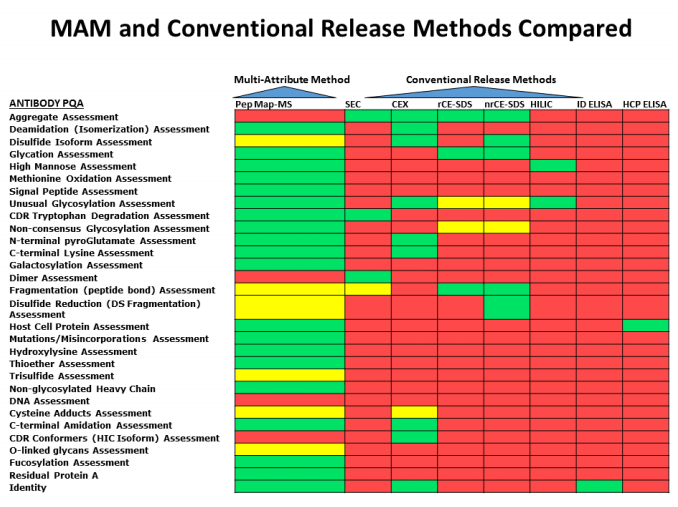 In a previous blog, we learned how you could Simplify Your Life with a Streamlined Workflow for Multiple Attribute Methodology (MAM). Based on the well-known technique of peptide mapping, a Liquid Chromatography-Mass Spectrometry-based MAM workflow (LC-MS MAM) enables molecular characterization and monitoring of a biotherapeutic for quality, safety, and efficacy throughout biological development and production. In particular, when performed with a SCIEX TripleTOF® 6600 System or X500B QTOF System, SWATH® Acquisition provides a powerfully simple strategy for initial characterization of the biologic, while BioPharmaView™ Software enables definition, monitoring, quantitation, purity testing, and reporting of Product Quality Attributes (PQAs) in one streamlined package for the entire workflow.
In a previous blog, we learned how you could Simplify Your Life with a Streamlined Workflow for Multiple Attribute Methodology (MAM). Based on the well-known technique of peptide mapping, a Liquid Chromatography-Mass Spectrometry-based MAM workflow (LC-MS MAM) enables molecular characterization and monitoring of a biotherapeutic for quality, safety, and efficacy throughout biological development and production. In particular, when performed with a SCIEX TripleTOF® 6600 System or X500B QTOF System, SWATH® Acquisition provides a powerfully simple strategy for initial characterization of the biologic, while BioPharmaView™ Software enables definition, monitoring, quantitation, purity testing, and reporting of Product Quality Attributes (PQAs) in one streamlined package for the entire workflow.
But what makes the LC-MS MAM workflow so compelling in the first place?
In a typical downstream biotherapeutic laboratory, many different assays are often required to fully characterize a biologic throughout development and production. For example, an assay based upon cation exchange chromatography (CEX) might be required for c-terminal amidation assessment or characterization of disulfide isoforms. Another type of assay, such as an enzyme-linked immunosorbent assay (ELISA) might be used to detect for any contamination from host-cell proteins, or simply to confirm the identity of the biotherapeutic in the first place. And yet, still another assay, such as hydrophilic interaction liquid chromatography (HILIC) may be used to assess overall glycoprofiles. These multiple and dissimilar assays are not only time-consuming, but they also require a multitude of expertise in many different analytical technologies.
With an LC-MS MAM workflow, all of these assays are combined into one. One assay can detect and quantitatively measure changes in the abundance of the biologic, c-terminal amidation, disulfide isoforms, host-cell protein contamination, and glycoforms – plus a lot more. The LC-MS MAM workflow also can detect and monitor oxidation, deamidation, hydroxylation, and other modifications as well as mutations and misincorporations and residual Protein A, among many other attributes. The LC-MS MAM workflow can replace a multitude of diverse assays with one direct analysis (Figure 1).

Figure 1. Comparison of LC-MS MAM Workflow with Conventional Assays.
And the analysis is direct. Many analytical techniques currently in use only provide an indirect measure of the attribute of interest. For example, a shift in the elution profile within a CEX assay only indicates that the net surface charge or conformation of the analyte has changed. But it doesn’t pinpoint exactly where that change has occurred. With an LC-MS MAM assay, you’ll not only know it’s because there’s deamidation occurring, but you’ll also know the specific sites of your biotherapeutic that are affected.
With a SCIEX LC-MS MAM assay, you’ll not only gain the ability to directly monitor a multitude of PQAs within one analysis, but you’ll also gain the ability to scan for new, previously unknown factors that may affect your biotherapeutic safety, efficacy, and purity. With the new peak detection feature within the SCIEX workflow, any new peaks that may arise due to any new impurities or contaminants entering the production process will be detected and flagged, before they have the potential to ruin an entire production batch.
By combining so many assays into one direct analysis, the LC-MS MAM workflow saves all of the effort and costs associated with supporting a multitude of diverse assays for biotherapeutic attribute monitoring and purity testing.Learn More about the LC-MS MAM Workflow and How It Can Maximize Your Biotherapeutic Production Efficiency >






 Contact Support
Contact Support
0 Comments